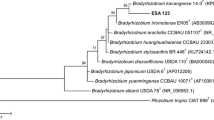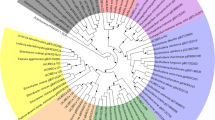Abstract
This study aimed to evaluate the effects of seed inoculation with Bradyrhizobium sp. and co-inoculation with Azospirillum brasilense. The seed treatments were as follows: control (without inoculation); A. brasilense (2 mL per kg−1 of seed); A. brasilense (4 mL per kg−1 of seed); Bradyrhizobium sp. (2 mL per kg−1 of seed); Bradyrhizobium sp. (4 mL per kg−1 of seed); A. brasilense + Bradyrhizobium sp. (2 mL of each strain per kg−1 of seed); and A. brasilense + Bradyrhizobium sp. (4 mL of each strain per kg−1 of seed). Peanut plants from seeds inoculated with Bradyrhizobium sp. and A. brasilense exhibited highest leaf concentration of photosynthetic pigments, carotenoids, nitrate, ammonia and amino acids. The inoculation of seeds with Bradyrhizobium sp. resulted in plants with increased concentrations of total soluble sugars, and ureides compared to the untreated plants. In contrast, seeds treated with A. brasilense alone resulted in plants exhibiting highest concentration of amino acids, which represent the highest concentration of nitrogen compounds in peanut plants. Seed inoculation with Bradyrhizobium sp. at a rate of 2 mL kg−1 was identified as the best treatment to promote increased biological nitrogen fixation and generate higher peanut yields.







Similar content being viewed by others
References
Andrade SR, Sant'anna R, Mosquim PR, Cambraia J (2001) Efeito da proporção NH4+/NO3-na distribuição de nitrato e na atividade in vitro da redutase do nitrato de plantas de Panicum maximum. Embrapa Cerrados-Boletim de Pesquisa e Desenvolvimento (INFOTECA-E) 12:1–16
Baral B, Izaguirre-Mayoral ML (2017) Purine-derived ureides under drought and salinity. In: Sparks D (ed) Advances in agronomy. Academic Press, Finland, pp 167–204
Baral B, Teixeira da Silva JA, Izaguirre-Mayoral ML (2016) Early signaling, synthesis, transport and metabolism of ureides. J Plant Physiol 193:97–109
Bárbaro IM, Brancalião SR, Ticelli M, Miguel FB, Silva JAA (2008) Técnica alternativa: coinoculação de soja com Azospirillum e Bradyrhizobium visando incremento de produtividade. [S. l.: s.n.]
https://www.infobibos.com/Artigos/2008_4/coinoculacao/index.htm. Accessed date: 03 May 2018.
Beltrão NEM, Sousa Junior SP, Oliveira MIP, Filho JMF, Silva MNB (2011) Ecofisiologia do amendoim. In: Beltrão NEM, Oliveira MIP (eds) Ecofisiologia das culturas de algodão, amendoim, gergelim, mamona, pinhão-manso e sisal. Embrapa Informação Tecnológica, Brasília, pp 125–162
Benintende S, Uhrich W, Herrera M, Gangge F, Sterren M, Benintende M (2010) Comparación entre coinoculación com Bradyrhizobium japonicum y Azospirillum brasilense e inoculación simple con Bradyrhizobium japonicum en la nodulación, crecimiento y acumulación de N en el cultivo de soja, 2nd edn. Agriscientia, Córdoba
Bieleski RL, Turner NA (1966) Separation and estimation of amino acids in crude plant extracts by thin-layer electrophoresis and chromatography. Anal Biochem 17:278–293
Carter AM, Tegeder M (2016) Increasing nitrogen fixation and seed development in soybean requires complex adjustments of nodule nitrogen metabolism and partitioning processes. Curr Biol 26:2044–2051
Cataldo DA, Maroon M, Schrader LE, Youngs VL (1975) Rapid colorimetric determination of nitrate in plant tissue by nitration of salicylic acid. Commun Soil Sci Plant Anal 6:71–80
Chibeba AM, Kyei-Boahen S, Guimarães MDF, Nogueira MA, Hungria M (2018) Feasibility of transference of inoculation-related technologies: a case study of evaluation of soybean rhizobial strains under the agro-climatic conditions of Brazil and Mozambique. Agr Ecosyst Environ 261:230–240
Companhia Nacional de Abastecimento - CONAB. Amendoim total (1º e 2º safra) Brasil: Série histórica da área plantada. https://www.conab.gov.br/conteudos. php?a=1252. Accessed date: 20 March 2018.
Dubois M, Gilles KA, Hamilton JK, Rebers PA, Smith F (1956) Colorimetric method for determination of sugars and related substances. Anal Chem 28:350–356
Faye B, Webber H, Diop M, Mbaye M, Owusu-Sekyere J, Naab JB, Gaiser T (2018) Potential impact of climate change on peanut yield in Senegal, West Africa. Field Crops Res 219:148–159
Ferlini HA (2006) Co-inoculación en soja (Glicyne max) con Bradyrhizobium japonicum y Azospirillum brasilense. [S.l.:s.n.],. https://www.engormix.com/ co_inoculacion_soja_ glicyne_s_articulos_800_AGR.htm . Accessed date: 21 May 2018.
Filgueiras G, Santos MA, Homma A, Rebello FK, da Silva Cravo M (2009) Aspectos socioeconômicos. In: Zilli JE, Vilarinho AA, Alves JMA (eds) A cultura do feijão-caupi na Amazônia Brasileira. Embrapa Roraima, Boa Vista, pp 23–58
Huang HQ, He FR, Chen ZH (1990) Study on the biological characteristic of fast-growing peanut rhizobial strains 85–7 and 85–19. J Sichuan Agric 8:188–193
Hungria M, Campo RJ (2005) Fixação biológica do nitrogênio em sistemas agrícolas. In: Congresso Brasileiro de Ciência do Solo, 30., 2005, Pernambuco. Solos, Sustentabilidade e Qualidade Ambiental. Pernambuco: SBCS, UFPE; Rio de Janeiro: Embrapa Solos. p.1–30
Hungria M, Megías M (2013) Uma década de ouro se aproxima para a microbiologia do solo: expectativas da pesquisa, da indústria, dos agricultores e da sociedade. Anais CNPSO, Seville
Hungria M, Vargas MAT, Campo RJ (1997) A inoculação da soja. Embrapa-CNPSo, Londrina
Izaguirre-Mayoral ML, Lazarovits G, Baral B (2018) Ureide metabolism in plant-associated bacteria: purine plant-bacteria interactive scenarios under nitrogen deficiency. Plant Soil 428:1–34
Juge C, Prévost D, Bertrand A, Bipfubusa M, Chalifour FP (2012) Growth and biochemical responses of soybean to double and triple microbial associations with Bradyrhizobium, Azospirillum and Arbuscular mycorrhizae. Appl Soil Ecol 61:147–157
Lamberto I, Percudani R, Gatti R, Folli C, Petrucco S (2010) Conserved alternative splicing of Arabidopsis transthyretin-like determines protein localization and S-allantoin synthesis in peroxisomes. Plant Cell 22:1564–1574
Lichtenthaler HK (1987) Chlorophylls and carotenoids: pigments of photosynthetic biomembranes. Methods Enzymol 148:350–382
Lugtenberg B, Kamilova F (2009) Plant-growth-promoting rhizobacteria. Annu Rev Microbiol 63:541–556
Mariano E, Santana Filho CR, Bortoletto-Santos R, Bendassolli JA, Trivelin PCO (2019) Ammonia losses following surface application of enhanced-efficiency nitrogen fertilizers and urea. Atmos Environ 203:242–251
McCullough H (1967) The determination of ammonia in whole blood by a direct colorimetric method. Clin Chim Acta 17:297–304
Moretti LG, Lazarini E, Bossolani JW, Parente T, Caioni S, Araujo RS, Hungria M (2018) Can additional inoculations increase soybean nodulation and grain yield? Agron J 110:715–721
Okon Y, Itzigsohn R (1995) The development of Azospirillum as a commercial inoculant for improving crop yields. Biotechnol Adv 13:415–424
Oliveira SM, Almeida REM, Ciampitti IA, Pierozan Junior C, Lago BC, Trivelin PCO, Favarin JL (2018) Understanding N timing in corn yield and fertilizer N recovery: an insight from an isotopic labeled-N determination. PLoS ONE ONE 13:e0192776–e192814
Ouyang W, Xu X, Hao Z, Gao X (2017) Effects of soil moisture content on upland nitrogen loss. J Hydrol 546:71–80
Paungfoo-Lonhienne C, Lonhienne TGA, Rentsch D, Robinson N, Christie M, Webb RI, Gamage HK, Carroll BJ, Schenk PM, Schmidt S (2008) Plants can use protein as a nitrogen source without assistance from other organisms. Proc Natl Acad Sci USA 105:4524–4529
Poffenbarger HJ, Sawyer JE, Barker DW, Olk DC, Six J, Castellano MJ (2018) Legacy effects of long-term nitrogen fertilizer application on the fate of nitrogen fertilizer inputs in continuous maize. Agr Ecosyst Environ 265:54555
Development Core Team R (2015) A language and environment for statistical computing. R Foundation for Statistical Computing, Vienna
Rocha K, Mariano E, Grassmann CS, Trivellin PCO, Rosolem CA (2019) Fate of 15N fertilizer applied to maize in rotation with tropical forage grasses. Field Crops Res 238:35–44
Romero AM, Vega D, Correa OS (2014) Azospirillum brasilense mitigates water stress imposed by a vascular disease by increasing xylem vessel area and stem hydraulic conductivity in tomato. Appl Soil Ecol 82:38–43
Santos CERS, Stamford NP, Freitas ADS, Vieira IMMB, Souto SM, Neves MCP, Rumjanek NG (2005) Efe-tividade de rizóbios isolados de solos da região Nordestedo Brasil na fixação do N2 em amendoim (Arachis hypogaea L.). Acta Sci 27:301–307
Shapiro SS, Wilk MB (1965) An analysis of variance test for normality (complete samples). Biometrika 52:591–611
Sizenando CIT, Ramos JPC, Fernandes-Júnior PI, De Lima LM, Freire RMM, dos Santos RC (2016) Agronomic efficiency of Bradyrhizobium in peanut under different environments in Brazilian Northeast. Afr J Agric Res 11:3482–3487
Teixeira JP, da Silva MTR, Lopes ES, Giardini AR (1981) Ocorrência de ureídeos em folhas de amendoim como indicativo de fixação simbiótica de nitrogênio atmosférico. Bragantia 40:193–197
Thies JE, Bohlool BB, Singleton PW (1991) Subgroups of the cowpea miscellany: symbiotic specificity within Bradyrhizobium spp. for Vigna unguiculata, Phaseolus lunatus, Arachis hypogaea, and Macroptilium atropurpureum. Appl Environ Microbiol 57:1540–1545
van Handel E (1967) Determination of fructose and fructose-yielding carbohydrates with cold anthrone. Anal Biochem 19:193–194
Vitousek PM, Menge DN, Reed SC, Cleveland CC (2013) Biological nitrogen fixation: rates, patterns and ecological controls in terrestrial ecosystems. Philos Trans R Soc Lond Ser B Biol Sci 368:20130119
Vogels GD, van der Drift C (1970) Differential analyses of glyoxylate derivatives. Anal Biochem 33:143–157
Volpin H, Kapulnik Y (1994) Interaction of Azospirillum with beneficial soil micro-organisms. In: Okon Y (ed) Azospirillum/plant associations. CRC Press, Boca Raton, pp 111–118
Wang X, Fan J, Xing Y, Xu G, Wang H, Deng J, Wang Y, Zhang F, Li P, Li Z (2018) The effects of mulch and nitrogen fertilizer on the soil environment of crop plants. Adv Agron. https://doi.org/10.1016/bs.agron.2018.08.003
Yemm EW, Cocking EC, Ricketts RE (1955) The determination of amino-acids with ninhydrin. Analyst 80:209–214
Zilli JE, Marson LC, Marson BF, Rumjanek NG, Xavier GR (2009) Contribuição de estirpes de rizóbio para o desenvolvimento e produtividade de grãos de feijão-caupi em Roraima. Embrapa Agrobiologia-Artigo em Periódico Indexado (ALICE) 39:749–758
Acknowledgements
The first author thanks the Brazilian Federal Agency for the Support and Evaluation of Graduate Education (Coordenação de Aperfeiçoamento de Pessoal de Nível Superior; CAPES) for the scholarship. ARR thanks the National Council for Scientific and Technological Development (CNPq) for the research fellowship (Grant number 309380/2017-0). The authors also thank Agrocete Indústria de Fertilizantes Ltda, for providing the inoculants GRAP NOD am (Bradyrhizobium sp., SEMIA 6144) and GRAP NOD a (Azospirillum brasilense, strains AbV5 and AbV6).
Author information
Authors and Affiliations
Corresponding author
Ethics declarations
Conflict of interest
The authors have no conflicts of interest to declare.
Additional information
Communicated by Erko Stackebrandt.
Publisher's Note
Springer Nature remains neutral with regard to jurisdictional claims in published maps and institutional affiliations.
Rights and permissions
About this article
Cite this article
Gericó, T.G., Tavanti, R.F.R., de Oliveira, S.C. et al. Bradyrhizobium sp. enhance ureide metabolism increasing peanuts yield. Arch Microbiol 202, 645–656 (2020). https://doi.org/10.1007/s00203-019-01778-x
Received:
Revised:
Accepted:
Published:
Issue Date:
DOI: https://doi.org/10.1007/s00203-019-01778-x




